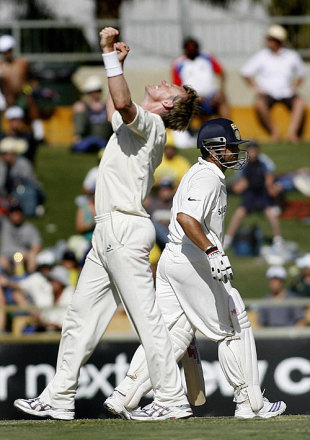Pitch was off the pace
For all the predictions of damage from Australia's four fast men there was not much blazing fire
Peter English at the WACA
16-Jan-2008
|
|

| |
For all the predictions of damage from Australia's four fast men there was not much blazing fire. Each of the quartet, which was steered superbly by Brett Lee, was sharp, but the expected explosiveness was missing after an energetic opening from both teams. A hot day sapped the early promise from the surface and rumours of Perth's bounce returning have been exaggerated, at least on the side of the square that hasn't been relaid.
In December Shaun Tait was almost unplayable during a Twenty20 international on one of the springy pitches, but in his third Test he was unable to create the same level of fear. India's batsmen were the most relieved while many of the rest, including the home bowlers, felt slightly deceived.
The last time Australia tried a combination of four fast men was against India 15 years ago and the match was won in five days. In the lead-up to this game there was speculation it would be a short one, but the home team will have to sweat to achieve the world record of 17 wins in a row.
Brett Lee and Mitchell Johnson opened, with the back-up coming from Tait and Stuart Clark, and while teeth were shown, the edges were soon blunted. Lee and Tait posted speeds above 150 kph in the first session, but they dropped to the low 140s in an afternoon of intense heat. A Tait bouncer barely reached Gilchrist on the full and a Sachin Tendulkar edge off Lee fell short of second slip. India's batsmen, particularly Tendulkar, were even able to re-think their shots, which is something that was not possible in Perth's prime.
Rather than having the luxury of unleashing his bowlers and watching them feed the cordon, Ricky Ponting had to be thoughtful. The slips stayed deep, but fielders were regularly rearranged in the infield and on the boundary, just as they were in the first two Tests.
A couple of wickets came with bowling changes, Lee swapping ends to pick up Wasim Jaffer and Mitchell Johnson returning to capture Sourav Ganguly with a slice to Michael Hussey, who took a fine diving catch. Dismissals that were meant for extreme speed came with cageyness instead.
At times it looked like the captain had too many riches and was not sure how to spend them. Andrew Symonds bowled five overs of medium pace in the second session after Tait had waited until shortly before lunch to be employed. Tait, who came in for Brad Hogg, was unsurprisingly erratic and more was expected when he had an aging ball, but he went without reward in 13 overs in three spells. Limited-overs games have provided most of his recent workload and he will need some time to run himself in.
Johnson was more effective than in Sydney and had two important wickets to show for the effort put in between Tests. Stronger in his delivery stride, he forced the batsmen to play more around off stump, picking up Virender Sehwag with an edge behind before removing Ganguly. An inswinging yorker was too fierce for Rahul Dravid, who was lucky to sustain only a sore foot and not an lbw dismissal.
| Rather than having the luxury of unleashing his bowlers and watching them feed the cordon, Ricky Ponting had to be thoughtful | |||
However, Lee was the most impressive and once he swapped ends after an expensive opening he operated like a well-tuned thoroughbred. Batsmen were forced to worry about nicking, Tendulkar missed a brilliant legcutter and the slips were always on alert. Jaffer pushed at Lee and gave Adam Gilchrist a simple catch and there were numerous challenges for India.
Dravid survived another drop in the series - Michael Clarke was the offender at first slip when the batsman was 11 - but Lee recovered and collected 3 for 64, a haul enhanced by the wicket of VVS Laxman with the second new ball. He powered towards the crease through 19 overs and Tendulkar's wicket came in his 15th, although the batsman was the unfortunate one this time. The ball was heading well over the stumps and might not have been in line with off. Asad Rauf upheld the lbw appeal.
The general rule in Perth is if the ball hits on the knee roll it can't be out. In the morning nobody would have believed a dismissal would have come this way, but the lack of spring in the pitch made it a possibility. While the surface may have tricked Rauf, it also flattened the bounce of Australia's fast-bowling posse.
Peter English is the Australasia editor of Cricinfo